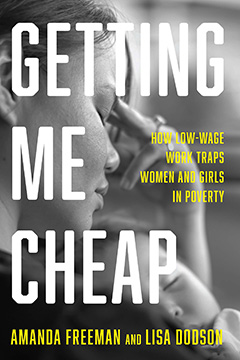Copyright © 2022 by Amanda Freeman and Lisa Dodson. This excerpt originally appeared in “Getting Me Cheap: How Low-Wage Work Traps Women and Girls in Poverty,” published by The New Press. Reprinted here with permission.
In a New York Times article, in November 2021, the journalists Eliza Shapiro and Gabriela Bhaskar introduced readers to Genesis, a sophomore in a northern Manhattan high school whose family was from the Dominican Republic. Genesis was college focused, interested in architecture and thinking about spreading her wings as she looked ahead. But the pandemic upended the family’s rhythm. Over the six months documented by the journalists, Genesis not only had to transition to online learning for her junior year of high school, but she was responsible for overseeing her six-year-old sister Maia’s schooling. Their single mother worked two jobs, so Genesis had to get her little sister up, fed, and onto the computer. “The rest of the day would be spent toggling between her own assignments and monitoring Maia’s needs, which invariably won out.” As the months passed, she spent hours each day trying to help her sister learn to read. As she described her role, Genesis said, “I have to keep in mind that I’m not her mom, I’m her sister.” But she worried about how hard her mother struggles and, looking ahead, that it would be difficult to move away to college, far away from Maia and her hardworking mom.
With some ups and downs, Genesis made it through high school buoyed by friends, family, and determination. Importantly, her story got told. The attention that comes with a substantive New York Times article exposed a long-ignored truth about girls’ lives in the United States. Yet, the demands and capabilities revealed in young Genesis’s daily life, while particular in detail and character, have been playing out throughout the nation for decades.
Unequal Girlhoods
Annette Lareau’s research draws out and explores differences in parenting approaches that reflect class and race in the United States. Children of the affluent are recipients of intensive parental attention, largely expressed through a wide array of enriching activities, counseling, sports, and other opportunities for individual cultivation. In sharp contrast, working-class children are expected to be self-sufficient and responsible for meeting basic milestones at school and in the world. Claire Cain Miller has reported on research that shows parents of all different income levels aspire to this intensive ideal, setting up low-income parents to fail since they don’t have the time and resources to devote to endless carpools and activities. Moms talked to us about the guilt they felt when forced to take low-wage jobs and patch together care for their kids, which often fell apart. They were frequently leaving children in “self-care” and relying on teens and children, predominantly girls, to take care of even younger children. Lisa recorded a teen girl who, upon listening to other girls describe their routine family-care work, said, “It’s all true. It’s all similar. I am the oldest daughter too . . . living with my mom and my three siblings, so I had to play my father’s role, and I had to be the father. . . . And it was a big responsibility and it changed me a lot.”
Wendy Luttrell points to the role of schools as reinforcing this classed framework. She examines how schooling is organized around an “illusion of the ‘care-free’ student.” Presumably, the ‘care-free’ parent is the female caregiver who is doing all the work behind the scenes. This model may in fact be the reality of wealthier children in the United States with some of the caregiving duties performed by hired help. But we heard how children face schooling expectations that largely ignore labor market pressures on their parents, pressures that configure family life beyond income poverty. Instability and uncertainty are absolutes for parents in millions of low-wage jobs. Freedom from daily care work and economic stress reflects the lives of affluent youth whose families can purchase all kinds of care and enrichment services, technology, and other options that free children to pursue self-cultivation. But for working-class and poor children, this kind of childhood is like another country, a far-off life. In the United States, childhood is a commodity reserved for those wealthy enough to buy it.



 This representation of girls’ lives and their growing power resonates among largely white, higher-income families. But the girlhood we heard described is generally missing from popular campaigns for girls’ empowerment, for building feminist pathways into STEM careers, and for nurturing girls’ leadership skills. Many of the women who traced their biographies with us noted how deep family ties and brutal wage poverty were imprinted on them right from the start. The economy gets their moms’ work for cheap and, behind that, children subsidize low wages by filling in for adults. Just as low-income women are overlooked in a personal choice model that dominates work and family debates, low-income girlhood remains missing from mainstream narratives about girls’ lives.
This representation of girls’ lives and their growing power resonates among largely white, higher-income families. But the girlhood we heard described is generally missing from popular campaigns for girls’ empowerment, for building feminist pathways into STEM careers, and for nurturing girls’ leadership skills. Many of the women who traced their biographies with us noted how deep family ties and brutal wage poverty were imprinted on them right from the start. The economy gets their moms’ work for cheap and, behind that, children subsidize low wages by filling in for adults. Just as low-income women are overlooked in a personal choice model that dominates work and family debates, low-income girlhood remains missing from mainstream narratives about girls’ lives. Amanda Freeman
Amanda Freeman